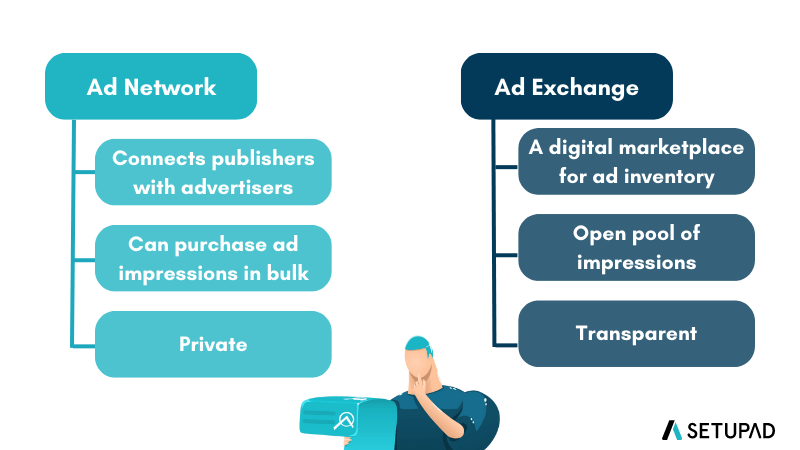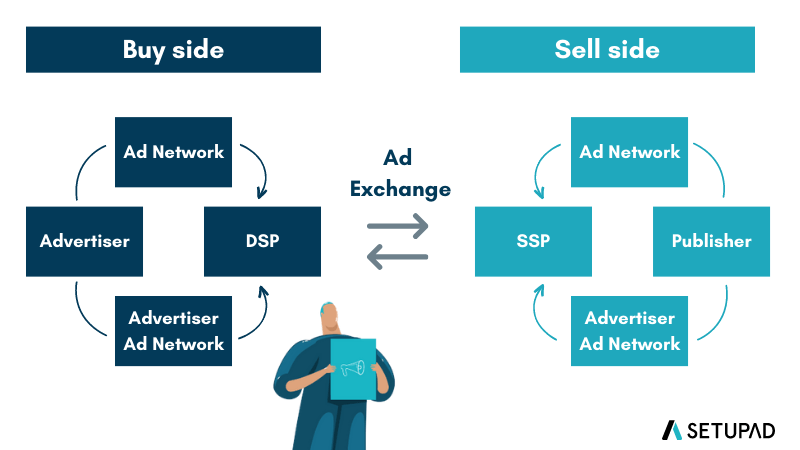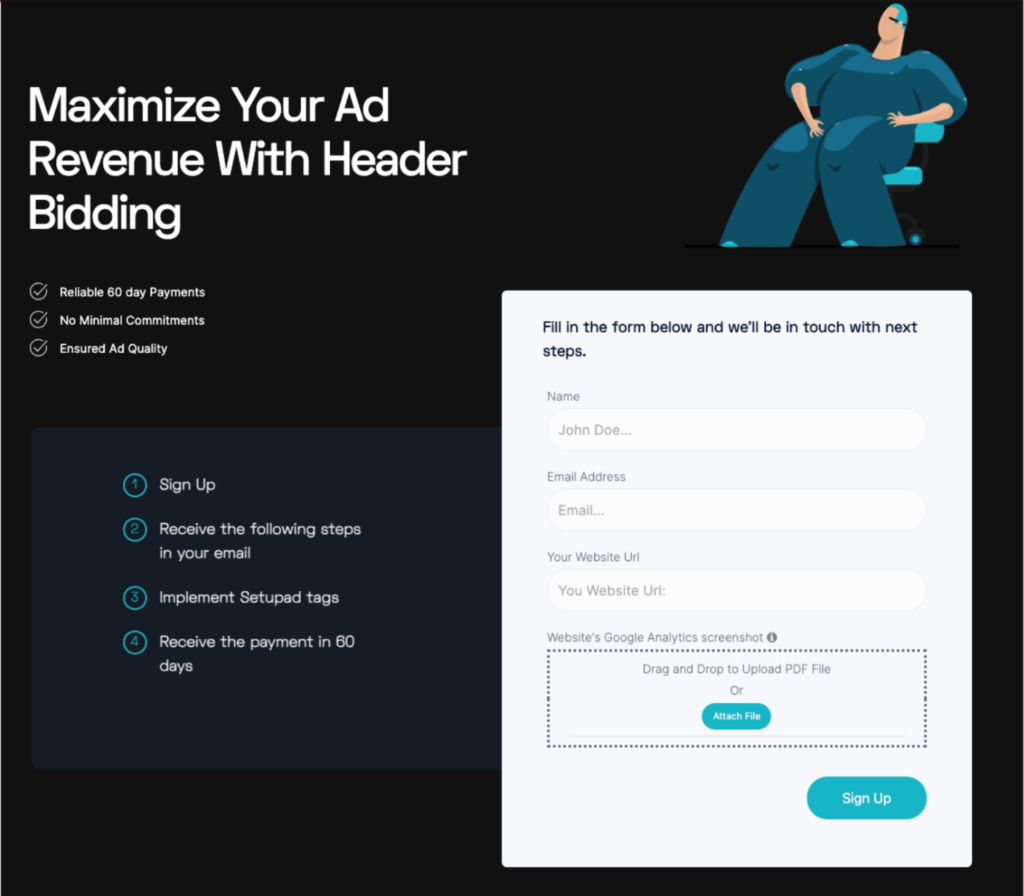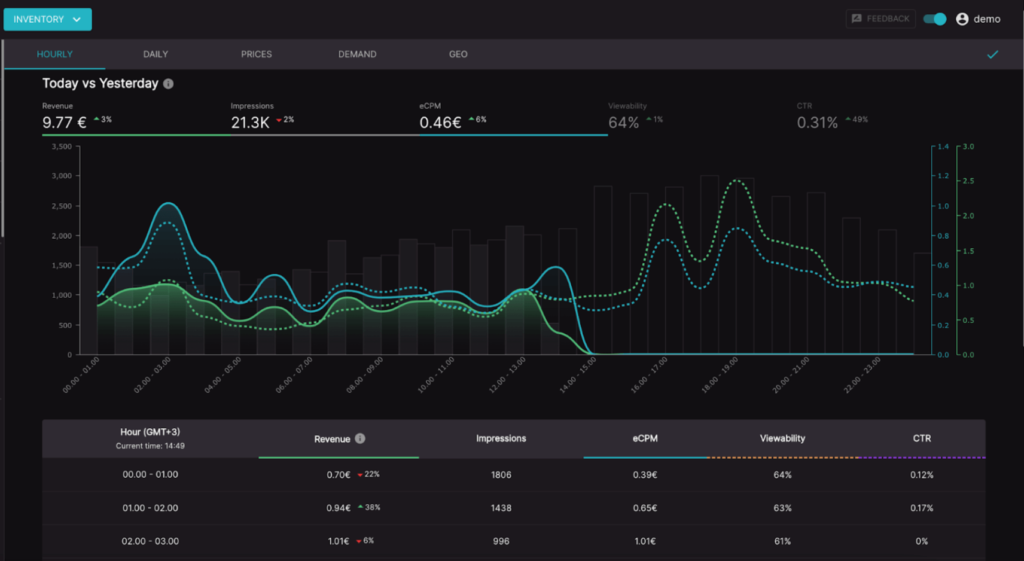A Publishers’ Guide to Ad Networks
Introduction
Ad networks, or advertising networks, are platforms or intermediaries connecting advertisers with publishers or website owners. Their main purpose is to facilitate the buying and selling of advertising space or inventory across a network of websites or apps.
Without ad networks, publishers would be required to negotiate deals with each advertiser individually, which would be time-consuming and inefficient.
In this article, we’ll cover what ad networks are, their role in the programmatic ecosystem, and how to choose the best ad network for your necessities!
What are Ad Networks?
The primary role of ad networks is to gather ad inventory that publishers haven’t sold (often referred to as remnant inventory) and connect it with advertisers seeking ad placements.
The ad network acts as a trusted intermediary, handling the logistics of ad delivery, targeting, and payment collection on behalf of both parties.
By partnering with ad networks, publishers can access a network of advertisers interested in purchasing ad space. Ad networks streamline the process by consolidating multiple advertisers into a single platform, making it easier for publishers to connect with potential buyers.
This eliminates the need for publishers to individually approach and negotiate deals with each advertiser, saving them significant time and effort.
Ad network types
There are 6 main ad network types, such as:
- Premium Ad Network. Ad networks that offer inventory from premium publishers.
- Vertical Ad Networks. Topic-specific ad networks, such as travel, technology, or business.
- Horizontal Ad Networks. Ad networks that deliver ads to a large inventory base available to the advertiser and offer an extensive reach. Horizontal ads offer scale, reach, and multiple targeting opportunities for advertisers.
- Inventory-Specific Ad Network. Ad networks that provide a specific type of ad inventory, such as video or mobile.
- Targeted Ad networks. Ad networks offer specific targeting capabilities built into the ad server.
- Affiliate Advertising Network. These ad networks act as intermediaries between publishers and advertisers, providing a platform for publishers to discover and join different affiliate programs. They offer various advertisers and products across different industries, enabling publishers to choose the ones that align with their audience and content.
What’s the difference between an ad network and an ad exchange?
An ad exchange is an online marketplace where programmatic advertising takes place. It enables advertisers to purchase ads across a wide range of mobile apps, mobile websites, and regular websites simultaneously.
Ad networks manage digital inventory from various publishers, purchase large quantities of ad impressions from ad exchanges, and then sell them to advertisers.
Ad exchanges provide a more transparent and efficient method for buying and selling digital ads. They use algorithms that enable publishers to receive the best prices for their ad impressions.
Simultaneously, advertisers can target specific audiences at the right time and in the appropriate context, eliminating the need to negotiate purchases directly with publishers.

What’s the difference between an ad network and an ad server?
To recognize the difference between an ad network and an ad server, it’s important to understand that ad networks (as well as publishers and advertisers) use an ad server as a part of their operations.
Ad servers are responsible for ad management, tracking impressions, and providing analytics. They store and serve the ads, ensuring they are displayed correctly on websites or mobile apps.
Ad servers also collect data on ad performance, such as impressions, clicks, and conversions, allowing advertisers and publishers to measure the effectiveness of their campaigns.
In contrast to ad servers, ad networks have a different role within the programmatic advertising ecosystem. Ad networks don’t focus on ad management or storage.
Instead, they primarily facilitate transactions between advertisers and publishers. As mentioned, ad networks serve as intermediaries, connecting advertisers with available ad inventory from publishers.
The ad network relies on the ad server’s capabilities to serve and track ads, ensuring they are displayed in the appropriate locations and optimized.
Simply put, the ad server serves as the underlying technology that enables advertisers to place their ads and assists publishers in efficiently handling these ads.
How Do Ad Networks Work?
Here are the 4 main steps that show how ad networks work:
- Publishers install one or more ad networks on their websites or mobile apps.
This allows them to tap into the network’s pool of advertisers and access additional opportunities to monetize their ad inventory.
- Conversely, advertisers select the ad network(s) they prefer to work with to set up their ad campaigns. They create their campaigns and define specific parameters for each one.
These parameters include budget allocation, audience targeting criteria, and frequency caps to control how often an ad is shown to individual users.
- When advertisers have their campaigns ready, the ad network considers their requirements.
- The ad network then uses its algorithms and targeting capabilities to determine which publishers are the most suitable for displaying the advertiser’s ads.
In summary, the ad network acts as a matchmaker, connecting the right advertisers with the appropriate publishers based on their needs and preferences.
How do ad networks operate in the digital advertising ecosystem?
Ad networks help publishers manage and monetize their ad inventory while providing advertisers access to a wide range of targeted ad inventory and optimization services. They play a vital role in the digital advertising ecosystem by facilitating efficient transactions and offering valuable services to both sides.
On the supply side
From the supply-side perspective, ad networks are crucial in helping publishers manage their digital ad inventory and maximize their revenue potential. Publishers have valuable ad space on their websites or mobile apps, and ad networks act as intermediaries between publishers and advertisers.
Ad networks assist publishers in organizing and categorizing the available ad space to make it more attractive to potential advertisers.
Ad networks also have a wide network of advertisers, allowing publishers to fill their ad inventory with relevant and high-paying ads.
By partnering with an ad network, publishers simplify monetizing their ad space. Instead of dealing with multiple advertisers individually, publishers can rely on the ad network to handle negotiations, ad delivery, and payment collection on their behalf.
This saves publishers time and resources while ensuring a steady revenue stream from their ad inventory.
On the demand side
Regarding the demand side, ad networks provide advertisers access to a broad range of ad inventory across different publishers, websites, and mobile apps. Advertisers can leverage ad networks to reach their target audience effectively.
Ad networks offer targeted advertising options to advertisers, such as demographic targeting, interest-based targeting, and contextual targeting. These targeting options enable advertisers to display their ads to the most relevant audience, increasing the likelihood of engagement and conversions.
Furthermore, ad networks optimize campaigns on behalf of advertisers.
Through algorithms and data analysis, they monitor the performance of ads in real time and make necessary adjustments to maximize campaign effectiveness. Ad networks provide insights and analytics to advertisers, helping them refine their strategies and achieve a better return on investment (ROI).

Benefits of Using Ad Networks for Publishers and Advertisers
The advantages of using an ad network depend on the user’s perspective.
For publishers: ad networks provide means to secure buyers for their unsold ad space, effectively monetizing inventory that would otherwise go unused.
However, the revenue generated through ad networks is generally lower than what publishers could earn through direct sales.
For advertisers: the benefit from ad networks comes from gaining access to a wide range of inventory options that match their target audience and budget considerations.
Ad networks help advertisers find suitable ad placements that align with their desired audience demographics and fit within their allocated advertising budget.
How to Choose the Right Ad Network for Your Website?
When selecting the best ad network, there are several factors to consider. The following 7 points highlight the key considerations:
1. Size of advertiser network.
The ad network’s advertiser base size is vital to evaluate the potential reach and ad fill rates. A more extensive network may offer more opportunities for advertisers, increasing the likelihood of better revenue for publishers.
2. Quality of ads in the network.
Assessing the quality of ads within the network is crucial. High-quality ads enhance user experience, leading to higher engagement and conversion rates. Ensuring that the ads align with your website’s content and target audience is essential.
3. Variety of available ad formats.
Look for an ad network that offers a diverse range of ad formats. This lets you choose formats that best suit your website’s layout and user experience. Having various options gives you the flexibility to experiment and optimize ad performance.
4. Compensation and payment terms.
Evaluate the compensation and payment terms offered by the ad network. Factors such as revenue share, payment frequency, and minimum payout thresholds should be considered to ensure they align with your financial goals and requirements.
5. Stability and User-Friendliness.
Select an ad network with a stable, reliable platform and minimal service disruptions. Additionally, prioritize a user-friendly interface and intuitive and easy-to-navigate tools. This will save you time and effort in managing your ad campaigns.
6. Additional support.
A reliable and responsive support team can be priceless in resolving any issues or concerns that may arise during your partnership with the ad network. They can provide guidance, answer questions, and address technical difficulties promptly, ensuring smooth operations and a positive experience for publishers.
A dedicated and knowledgeable support team can significantly contribute to the success of your ad campaigns and overall satisfaction with the ad network.
7. Underlying technology.
Analyze the underlying technology the ad network uses, as it is crucial in optimizing ad performance and revenue potential.
A robust and advanced technology infrastructure can enhance ad targeting capabilities, improve ad delivery speed, and provide comprehensive reporting and analytics tools.
How to Integrate Ad Networks?
Here are the 6 main steps that show how you can integrate ad networks with your website or app:
- Choose the right ad network. Select the ad network that aligns with your requirements, such as target audience, ad formats, and revenue models. Research and compare different ad networks to find the ones that fit your needs.
- Sign up and create an account. Register with the chosen ad network and create an account. This typically involves providing your website or app information and contact details and agreeing to the network’s terms and conditions.

- Obtain ad network code/tags. The ad network will provide you with specific code snippets or tags after signing up. These are usually JavaScript or HTML codes that you must implement on your website or app to display the ad placements.
- Implement code/tags. Place the provided code or tags in the appropriate sections of your website or app. This may involve modifying your website’s HTML or integrating the code within your app’s source code. An ad network may do it for you if this feature is available.
- Test and verify. Once the code/tags are implemented, thoroughly test the integration to ensure that ads are displayed correctly and that they align with your website or app’s design and user experience. Verify that the ads are loading properly and tracking the necessary metrics.
- Monitor and optimize. Keep track of the ad performance and metrics through the ad network’s reporting tools or dashboard. Analyze the data to optimize the placement, formats, and targeting for better revenue generation and user engagement. This may involve experimenting with different ad formats, positions, and targeting settings.
It’s important to note that the specific steps and implementation process may vary depending on the ad network and your platform (website, mobile app, etc.).
Ad network documentation, guides, and support teams are valuable resources to consult throughout the integration process, as they can provide specific instructions and address any technical challenges you may encounter.
Ad Network Monetization Models
Online ad networks commonly employ 5 revenue models to generate income. These revenue models are CPM, CPC, CPA, CPI, and CPV. It’s also possible to employ a revenue sharing or sponsorship model.
Let’s take a closer look at each of these models:
Cost per Mille (CPM)
CPM is based on the number of ad impressions per thousand views.
Advertisers are charged a fixed rate for every thousand times their ad is shown, regardless of the number of clicks or actions taken. CPM is often used to enhance brand exposure and awareness.
Cost per Click (CPC)
Advertisers pay for every click their ad receives on the publisher’s platform in this model.
The cost is determined by the number of clicks the ad generates, regardless of the number of impressions it receives.
Cost per Action (CPA)
With this model, advertisers are charged based on user actions.
The advertiser defines chargeable actions like clicks, sales, downloads, or other desired user engagements. Advertisers pay when users complete these predefined actions.
Cost Per Install (CPI)
CPI is primarily used in the mobile app advertising space. Advertisers pay for each installation of their app on a user’s device.
This model is commonly employed by outsourcing development or businesses looking to drive app downloads and installations.
Cost per View (CPV)
This model involves advertisers paying for each ad view. It’s commonly used in video campaigns, where advertisers are charged for each time a user views their video ad.
Revenue Sharing
Publishers can receive a percentage of the revenue generated from the ads displayed on their platform. Most of the time, the revenue share is 80:20.
Sponsorships
Publishers can partner with brands for sponsored content or specific advertising campaigns, earning a fee for promoting their products or services.
Ad Network Optimization Strategies
Ad network optimization strategies enable to maximize the revenue generated from ad placements on publisher websites or apps. These strategies involve different tactics to improve the performance and effectiveness of ad networks, such as:
- Experimenting with different ad formats, ad sizes, and placements to find the most engaging and effective combinations.
- Segmenting audience based on demographics and interests to deliver more targeted and relevant ads.
- Conducting A/B tests to compare different versions of ads and identify the most effective elements.
- Analyzing performance data to make data-driven decisions and optimize ad inventory.
- Implementing smart ad refresh and frequency capping to strike a balance between maximizing ad impressions and providing a positive user experience.
Related article: What is Ad Refresh
Ad Fraud and Ad Network Security
Ad fraud refers to deceptive activities in the digital advertising industry that aim to exploit publishers and advertisers by generating fraudulent impressions, clicks, or conversions.
By staying proactive and responsive to emerging threats, ad networks work diligently to maintain a secure environment where advertisers can confidently reach their target audience and publishers can monetize their ad inventory without falling victim to fraudulent practices.
- How do ad networks combat ad fraud?
To tackle this issue, ad networks can employ different strategies, such as traffic verification and filtering systems to detect and eliminate fraudulent or low-quality traffic. Advanced fraud detection tools, powered by machine learning algorithms, identify abnormal patterns and fraudulent activities in real-time.
Ad networks also rely on manual review processes to assess publishers and their inventory for legitimacy. They employ viewability metrics, verification technologies, and anti-fraud partnerships to ensure real users see ads and prevent fraudsters from manipulating ad view counts.
Ad Network Performance Tracking and Reporting
Ad network performance tracking and reporting are crucial to evaluate the effectiveness and success of ad campaigns running through ad networks.
Publishers can track essential metrics in real-time by using analytics tools and reporting dashboards provided by the ad network or third-party solutions.
Below is an example of Setupad’s reporting client dashboard.

By using advanced reporting dashboard, publishers can identify the best-performing ad units, optimize their ad inventory, and make informed decisions about ad placement and formats that resonate well with their audience.
It also allows publishers to track revenue streams, calculate earnings, and make data-driven decisions about their ad network partnerships.
How to Assess Ad Network Performance and ROI?
There are 4 key performance indicators (KPIs), which help to maintain and analyze ad network performance:
- Click-through rate (CTR) measures the percentage of users who click on an ad, indicating its effectiveness in generating interest.
- The conversion rate calculates the number of users who completed a desired action, such as purchasing or signing up.
- Cost per acquisition (CPA) evaluates the cost of acquiring each customer, helping determine campaign profitability.
- Return on ad spend (ROAS) quantifies the revenue generated relative to ad spend, offering insights into campaign profitability.
Additionally, tracking overall campaign performance, impressions, reach, and engagement can also help to evaluate ad network performance and ROI.
Types of Ad Networks
Native ad networks
Native ad networks (e.g., Adsterra) connect publishers with advertisers who want to deliver native ads. Native ads are designed to blend seamlessly with the surrounding content, providing a non-disruptive and engaging user experience.
These ad networks provide tools and resources to help publishers optimize their native ad placements, ensuring that the ads are relevant, contextual, and visually appealing.
Video ad networks
Video ad networks (e.g., Publift) specialize in delivering video ads to publishers. They connect publishers with advertisers who want to display video ads on their platforms.
Video ads can be displayed within the video content (instream), as standalone video ads (outstream), or within standard display ad units (in-banner). Video ad networks provide access to a wide range of video ad formats and offer advanced targeting and optimization features.
Mobile ad networks
Mobile ad networks (e.g., AdMob) focus on delivering ads on mobile devices such as smartphones and tablets. They connect publishers with advertisers who want to reach mobile users through mobile apps (in-app advertising) or mobile websites.
Mobile ad networks offer different ad formats, including display ads, interstitials, native ads, and rewarded ads. These networks often offer advanced targeting options based on user behavior, location, and demographic information.
Connected TV (CTV) ad networks
Connected TV (CTV) ad networks (e.g., Magnite) deliver internet-connected television ads. They connect publishers with advertisers who want to reach viewers through smart TVs, streaming devices, and other CTV platforms.
As more viewers shift towards streaming services and CTV platforms, this type of ad network allows publishers to monetize their CTV inventory. CTV ad networks can offer advanced targeting capabilities and help publishers optimize their ad placements
Setupad Solution
Setupad is a highly advanced monetization platform that empowers publishers to maximize their website revenue.
With the Setupad Header Bidding Wrapper, publishers can achieve a remarkable revenue increase of at least 30% compared to Google AdSense alone. This exceptional growth is made possible by leveraging demand from not just Google, but also 31 other demand partners (SSPs).
Additionally, Setupad offers access to Google AdX, a premium ad exchange where advertisers bid higher prices than AdSense. While traditional requirements often demand 5 million monthly pageviews and 10 million monthly ad impressions for at least six months, Setupad offers immediate access to Google AdX through the Setupad Prebid Manage Account.
This includes features like Open Bidding, optimized price floors, and Setupad direct deals campaigns.
Setupad Prebid AdSense product for large AdSense publishers seamlessly combines AdSense demand with Setupad’s Prebid demand from over 30 premium SSPs. Our products are fully optimized with Google, incorporating server-side integrations for faster bid responses and enhanced performance.
Choose Setupad as your trusted alternative for effective monetization results, and sign up today!
Conclusion
Ad networks play a vital role in the advertising ecosystem by simplifying the process of monetizing ad space for publishers. They act as intermediaries between publishers and advertisers, connecting them and handling logistics such as ad delivery, targeting, and payment collection.
Ad networks provide a network of potential buyers for publishers, saving them time and effort. They also offer advertisers access to a wide range of targeted ad inventory and optimization services, increasing the effectiveness of their campaigns.
By facilitating efficient transactions and offering valuable services, ad networks contribute to the success of both publishers and advertisers in the digital advertising landscape.
FAQs
What are the main advantages of using ad networks?
Ad networks help publishers reach their target audience through online advertising. By partnering with ad networks, publishers can connect with a large pool of potential advertisers, increasing their revenue and delivering relevant ads to their audience.
How do I choose the right ad network for my website?
When seeking ad network partners as a publisher, it’s important to prioritize relevant industry experience, expertise, and reputation. Additionally, ensure the ad network maintains transparency, high-quality standards, and compliance measures. Consider their approach to handling fraud, privacy, and data protection to make an informed decision.
What are the most popular ad networks in the industry?
Google AdSense is one of the most well-known and widely used ad networks.
How can I integrate ad networks into my website or app?
You need to sign up with your chosen ad network, create an account, and place ad tags or code generated by the network on your website or mobile app. The ad network’s technology will then dynamically serve relevant ads based on the publisher’s content and the visitor’s profile.
What are the different monetization models offered by ad networks?
Ad networks offer five common monetization models: CPM, CPC, CPA, CPI, and CPV. Some ad networks employ revenue sharing or sponsorship models.
How can I optimize ad performance within an ad network?
You can optimize ad performance within an ad network by analyzing audience demographics, targeting effectively, optimizing ad placements, monitoring performance metrics, and building a strong audience through quality content and user experience.
What measures do ad networks take to combat ad fraud?
Ad networks combat ad fraud by implementing sophisticated fraud detection systems, employing advanced algorithms to detect fraudulent activities, monitoring traffic quality and sources, implementing strict verification processes, partnering with third-party fraud prevention tools, and continuously improving their security measures to ensure the integrity of ad campaigns.
How can I track and analyze the performance of ad networks?
You can use tracking tools provided by the ad networks, use analytics platforms to monitor key metrics such as impressions, clicks, and conversions, implement unique tracking codes or pixels for precise tracking, conduct A/B testing to compare different ad network performance, and leverage data-driven insights to optimize ad placements and maximize revenue.
What are some emerging trends in the ad network landscape?
Some of the most critical trends in the ad network landscape include the increasing importance of mobile advertising due to the growing use of smartphones and tablets, the integration of AI and machine learning for enhanced targeting and personalization, and the focus on data privacy and compliance with regulations like GDPR.


